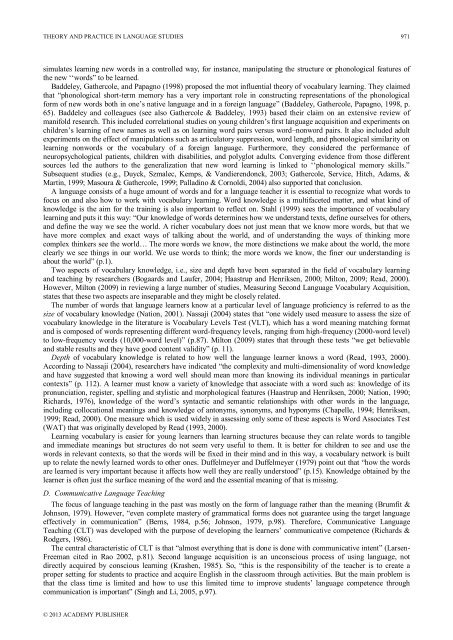Theory and Practice in Language Studies Contents - Academy ...
Theory and Practice in Language Studies Contents - Academy ...
Theory and Practice in Language Studies Contents - Academy ...
Create successful ePaper yourself
Turn your PDF publications into a flip-book with our unique Google optimized e-Paper software.
THEORY AND PRACTICE IN LANGUAGE STUDIES 971simulates learn<strong>in</strong>g new words <strong>in</strong> a controlled way, for <strong>in</strong>stance, manipulat<strong>in</strong>g the structure or phonological features ofthe new „„words” to be learned.Baddeley, Gathercole, <strong>and</strong> Papagno (1998) proposed the mot <strong>in</strong>fluential theory of vocabulary learn<strong>in</strong>g. They claimedthat “phonological short-term memory has a very important role <strong>in</strong> construct<strong>in</strong>g representations of the phonologicalform of new words both <strong>in</strong> one‟s native language <strong>and</strong> <strong>in</strong> a foreign language” (Baddeley, Gathercole, Papagno, 1998, p.65). Baddeley <strong>and</strong> colleagues (see also Gathercole & Baddeley, 1993) based their claim on an extensive review ofmanifold research. This <strong>in</strong>cluded correlational studies on young children‟s first language acquisition <strong>and</strong> experiments onchildren‟s learn<strong>in</strong>g of new names as well as on learn<strong>in</strong>g word pairs versus word–nonword pairs. It also <strong>in</strong>cluded adultexperiments on the effect of manipulations such as articulatory suppression, word length, <strong>and</strong> phonological similarity onlearn<strong>in</strong>g nonwords or the vocabulary of a foreign language. Furthermore, they considered the performance ofneuropsychological patients, children with disabilities, <strong>and</strong> polyglot adults. Converg<strong>in</strong>g evidence from those differentsources led the authors to the generalization that new word learn<strong>in</strong>g is l<strong>in</strong>ked to „„phonological memory skills.”Subsequent studies (e.g., Duyck, Szmalec, Kemps, & V<strong>and</strong>ierendonck, 2003; Gathercole, Service, Hitch, Adams, &Mart<strong>in</strong>, 1999; Masoura & Gathercole, 1999; Pallad<strong>in</strong>o & Cornoldi, 2004) also supported that conclusion.A language consists of a huge amount of words <strong>and</strong> for a language teacher it is essential to recognize what words tofocus on <strong>and</strong> also how to work with vocabulary learn<strong>in</strong>g. Word knowledge is a multifaceted matter, <strong>and</strong> what k<strong>in</strong>d ofknowledge is the aim for the tra<strong>in</strong><strong>in</strong>g is also important to reflect on. Stahl (1999) sees the importance of vocabularylearn<strong>in</strong>g <strong>and</strong> puts it this way: “Our knowledge of words determ<strong>in</strong>es how we underst<strong>and</strong> texts, def<strong>in</strong>e ourselves for others,<strong>and</strong> def<strong>in</strong>e the way we see the world. A richer vocabulary does not just mean that we know more words, but that wehave more complex <strong>and</strong> exact ways of talk<strong>in</strong>g about the world, <strong>and</strong> of underst<strong>and</strong><strong>in</strong>g the ways of th<strong>in</strong>k<strong>in</strong>g morecomplex th<strong>in</strong>kers see the world… The more words we know, the more dist<strong>in</strong>ctions we make about the world, the moreclearly we see th<strong>in</strong>gs <strong>in</strong> our world. We use words to th<strong>in</strong>k; the more words we know, the f<strong>in</strong>er our underst<strong>and</strong><strong>in</strong>g isabout the world” (p.1).Two aspects of vocabulary knowledge, i.e., size <strong>and</strong> depth have been separated <strong>in</strong> the field of vocabulary learn<strong>in</strong>g<strong>and</strong> teach<strong>in</strong>g by researchers (Bogaards <strong>and</strong> Laufer, 2004; Haastrup <strong>and</strong> Henriksen, 2000; Milton, 2009; Read, 2000).However, Milton (2009) <strong>in</strong> review<strong>in</strong>g a large number of studies, Measur<strong>in</strong>g Second <strong>Language</strong> Vocabulary Acquisition,states that these two aspects are <strong>in</strong>separable <strong>and</strong> they might be closely related.The number of words that language learners know at a particular level of language proficiency is referred to as thesize of vocabulary knowledge (Nation, 2001). Nassaji (2004) states that “one widely used measure to assess the size ofvocabulary knowledge <strong>in</strong> the literature is Vocabulary Levels Test (VLT), which has a word mean<strong>in</strong>g match<strong>in</strong>g format<strong>and</strong> is composed of words represent<strong>in</strong>g different word-frequency levels, rang<strong>in</strong>g from high-frequency (2000-word level)to low-frequency words (10,000-word level)” (p.87). Milton (2009) states that through these tests “we get believable<strong>and</strong> stable results <strong>and</strong> they have good content validity” (p. 11).Depth of vocabulary knowledge is related to how well the language learner knows a word (Read, 1993, 2000).Accord<strong>in</strong>g to Nassaji (2004), researchers have <strong>in</strong>dicated “the complexity <strong>and</strong> multi-dimensionality of word knowledge<strong>and</strong> have suggested that know<strong>in</strong>g a word well should mean more than know<strong>in</strong>g its <strong>in</strong>dividual mean<strong>in</strong>gs <strong>in</strong> particularcontexts” (p. 112). A learner must know a variety of knowledge that associate with a word such as: knowledge of itspronunciation, register, spell<strong>in</strong>g <strong>and</strong> stylistic <strong>and</strong> morphological features (Haastrup <strong>and</strong> Henriksen, 2000; Nation, 1990;Richards, 1976), knowledge of the word‟s syntactic <strong>and</strong> semantic relationships with other words <strong>in</strong> the language,<strong>in</strong>clud<strong>in</strong>g collocational mean<strong>in</strong>gs <strong>and</strong> knowledge of antonyms, synonyms, <strong>and</strong> hyponyms (Chapelle, 1994; Henriksen,1999; Read, 2000). One measure which is used widely <strong>in</strong> assess<strong>in</strong>g only some of these aspects is Word Associates Test(WAT) that was orig<strong>in</strong>ally developed by Read (1993, 2000).Learn<strong>in</strong>g vocabulary is easier for young learners than learn<strong>in</strong>g structures because they can relate words to tangible<strong>and</strong> immediate mean<strong>in</strong>gs but structures do not seem very useful to them. It is better for children to see <strong>and</strong> use thewords <strong>in</strong> relevant contexts, so that the words will be fixed <strong>in</strong> their m<strong>in</strong>d <strong>and</strong> <strong>in</strong> this way, a vocabulary network is builtup to relate the newly learned words to other ones. Duffelmeyer <strong>and</strong> Duffelmeyer (1979) po<strong>in</strong>t out that “how the wordsare learned is very important because it affects how well they are really understood” (p.15). Knowledge obta<strong>in</strong>ed by thelearner is often just the surface mean<strong>in</strong>g of the word <strong>and</strong> the essential mean<strong>in</strong>g of that is miss<strong>in</strong>g.D. Communicative <strong>Language</strong> Teach<strong>in</strong>gThe focus of language teach<strong>in</strong>g <strong>in</strong> the past was mostly on the form of language rather than the mean<strong>in</strong>g (Brumfit &Johnson, 1979). However, “even complete mastery of grammatical forms does not guarantee us<strong>in</strong>g the target languageeffectively <strong>in</strong> communication” (Berns, 1984, p.56; Johnson, 1979, p.98). Therefore, Communicative <strong>Language</strong>Teach<strong>in</strong>g (CLT) was developed with the purpose of develop<strong>in</strong>g the learners‟ communicative competence (Richards &Rodgers, 1986).The central characteristic of CLT is that “almost everyth<strong>in</strong>g that is done is done with communicative <strong>in</strong>tent” (Larsen-Freeman cited <strong>in</strong> Rao 2002, p.81). Second language acquisition is an unconscious process of us<strong>in</strong>g language, notdirectly acquired by conscious learn<strong>in</strong>g (Krashen, 1985). So, “this is the responsibility of the teacher is to create aproper sett<strong>in</strong>g for students to practice <strong>and</strong> acquire English <strong>in</strong> the classroom through activities. But the ma<strong>in</strong> problem isthat the class time is limited <strong>and</strong> how to use this limited time to improve students‟ language competence throughcommunication is important” (S<strong>in</strong>gh <strong>and</strong> Li, 2005, p.97).© 2013 ACADEMY PUBLISHER
















